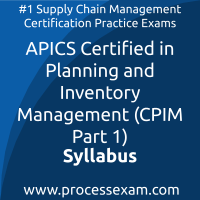 To achieve the professional designation of APICS Planning and Inventory Management - Part 1 from the APICS, candidates must clear the CPIM Part 1 Exam with the minimum cut-off score. For those who wish to pass the APICS Planning and Inventory Management - Part 1 certification exam with good percentage, please take a look at the following reference document detailing what should be included in APICS CPIM 7.0 P1 Exam preparation.
To achieve the professional designation of APICS Planning and Inventory Management - Part 1 from the APICS, candidates must clear the CPIM Part 1 Exam with the minimum cut-off score. For those who wish to pass the APICS Planning and Inventory Management - Part 1 certification exam with good percentage, please take a look at the following reference document detailing what should be included in APICS CPIM 7.0 P1 Exam preparation.
The APICS CPIM Part 1 Exam Summary, Body of Knowledge (BOK), Sample Question Bank and Practice Exam provide the basis for the real APICS Certified in Planning and Inventory Management (CPIM Part 1) exam. We have designed these resources to help you get ready to take APICS Planning and Inventory Management - Part 1 (CPIM Part 1) exam. If you have made the decision to become a certified professional, we suggest you take authorized training and prepare with our online premium APICS Planning and Inventory Management - Part 1 Practice Exam to achieve the best result.
APICS CPIM Part 1 Exam Summary:
| Exam Name | APICS Planning and Inventory Management - Part 1 |
| Exam Code | CPIM Part 1 |
| PLUS member Exam Fee | USD $545 |
| CORE member/nonmember Exam Fee | USD $760 |
| Retake Exam Fees for Member with Certification | USD $385 |
| Retake Fees Members and Nonmembers | USD $470 |
| Exam Duration | 210 Minutes |
| Number of Questions | 150 |
| Passing Score | 300 / 350 |
| Format | Multiple Choice Questions |
| Schedule Exam | Pearson VUE |
| Sample Questions | APICS CPIM 7.0 P1 Exam Sample Questions and Answers |
| Practice Exam | APICS Certified in Planning and Inventory Management (CPIM Part 1) Practice Test |
APICS Planning and Inventory Management - Part 1 Syllabus Topics:
| Topic | Details | Weights |
| Supply Chain Overview |
- A supply chain is a global network used to deliver products and services, from raw materials to finished goods, to end consumers through a flow of information, physical distribution, and cash. A supply chain consists of retailers, distributors, warehouses, and suppliers participating in the production, delivery, and sale of a product or service to the consumer. - The supply chain satisfies the market strategy through a variety of business functions. Critical factors include product volume and variety, customer service level, lead times, customization, product life cycle, costs, and strategy. A. Operational Objectives to Meet Competitive Priorities |
17% |
| Fundamentals of Demand Management |
- Demand management is the function of recognizing and managing all demands for products or services. Demand management includes several major activities, all of which are primarily market driven and include identifying all product and service demand in the defined markets. Demand management includes forecasting but also involves possible segmenting of markets, classifying customers, and identifying demand. A. Determine Customer Needs, Specifications, and Features and Create a Product Roadmap B. Product Management C. Review Demand Types and Sources D. Forecast Demand |
10% |
| Plan Supply |
- Master scheduling process creates a master production schedule (MPS) based on input from the sales and operation plan, the external environment, and the internal environment. A. Create master production schedule (MPS) |
10% |
| Execute Supply Plan |
A. Buy B. Make |
24% |
| Inventory Management |
- Those stocks or items used to support production (raw materials and work in process (WIP) items), supporting activities (maintenance, repair, and operating supplies), customer service (finished goods and spare parts), and specialized inventory. A. Plan inventory investment and days of supply |
30% |
| Continuous Improvement /Quality Management and Technologies |
A. Continuous Improvement B. Information, Process, and Emerging Technology |
9% |
Both APICS and veterans who’ve earned multiple certifications maintain that the best preparation for a APICS CPIM Part 1 professional certification exam is practical experience, hands-on training and practice exam. This is the most effective way to gain in-depth understanding of APICS CPIM 7.0 P1 concepts. When you understand techniques, it helps you retain APICS Planning and Inventory Management - Part 1 knowledge and recall that when needed.
